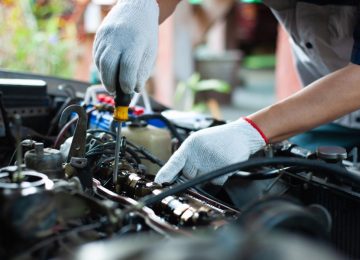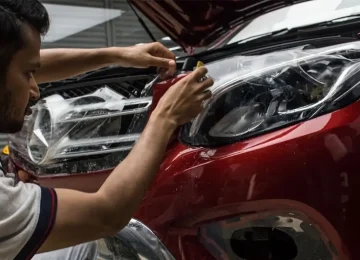Welding plays a critical role in the automotive industry, ensuring the structural integrity, durability, and safety of vehicles. From chassis assembly to the creation of complex body structures, metal welding technologies have advanced significantly to meet the automotive industry’s demands for efficiency, strength, and sustainability.
In this article, we will explore the various welding methods used in automotive manufacturing, the materials involved, and the key considerations in choosing the right welding process.
Importance of Welding in the Automotive Industry
Welding is a sheet metal fabrication process that permanently joins metal components by applying heat, pressure, or both. The automotive industry relies heavily on metal welding to create strong, lightweight vehicles that meet safety regulations while maintaining cost-effectiveness. Components such as frames, exhaust systems, panels, and even engine parts are often welded together, making the process an essential part of vehicle manufacturing.
The rise of electric vehicles (EVs), fuel-efficient designs, and modern materials like aluminum and advanced high-strength steels (AHSS) have spurred further innovation in welding technologies.
Common Welding Methods Used in the Automotive Industry
Custom metal welding techniques are commonly employed in the automotive sector. Each method is suited to specific materials, applications, and production volumes. Here are the most widely used welding processes in the automotive industry:

1. Resistance Spot Welding (RSW)
One of the most commonly used methods in automotive manufacturing, resistance spot welding (RSW) joins two or more metal sheets by applying pressure and heat generated from electrical resistance. This technique is widely employed for assembling body panels, particularly in high-volume production environments.
Advantages:
- High production speed
- Low cost
- Minimal heat-affected zones
- Excellent for thin metal sheets
2. Gas Metal Arc Welding (GMAW/MIG Welding)
MIG welding method is favored for its adaptability, high material deposition rates, and suitability for automation.
Advantages:
- Suitable for both thin and thick materials
- High efficiency and minimal post-weld cleaning
- Compatible with a wide range of metals, including aluminum

3. Laser Beam Welding (LBW)
Laser beam welding (LBW) employs a concentrated laser beam to precisely melt and fuse materials, allowing for extreme accuracy. This high-speed, automated welding process is ideal for joining complex and delicate automotive components, offering excellent strength-to-weight ratios.
Advantages:
- High precision and minimal distortion
- Deep weld penetration
- High-speed welding, ideal for mass production
4. Friction Stir Welding (FSW)
Friction stir welding (FSW) is a solid-state process where metal parts are joined without melting, ensuring strong, seamless bonds. Instead, frictional heat is used to soften the material, which is stirred together to form a weld. FSW is commonly used in aluminum-intensive applications such as lightweight vehicle structures.
Advantages:
- Produces strong, defect-free joints
- No need for filler materials or shielding gases
- Excellent for joining dissimilar metals
5. Tungsten Inert Gas Welding (TIG Welding)
TIG welding, or gas tungsten arc welding (GTAW), is a meticulous welding technique that utilizes a tungsten electrode that does not get consumed and an inert argon gas to protect the welding area. Although slower than other methods, TIG welding is preferred for applications that require precision and high-quality finishes.
Advantages:
- Excellent control over the weld pool
- Produces high-quality, strong welds
- Ideal for welding thin sections of stainless steel and non-ferrous metals

Welding Materials in the Automotive Industry
The materials used in automotive manufacturing have evolved significantly over the years, with a strong focus on reducing vehicle weight while maintaining or improving strength and safety. The most common materials involved in automotive welding include:
- Steel: Traditional mild steel and newer advanced high-strength steels (AHSS) are extensively used for body structures, frames, and safety-critical components due to their strength and formability.
- Aluminum: Aluminum is increasingly used in lightweight vehicles and electric vehicles (EVs) for components such as chassis and body panels, thanks to its low density and corrosion resistance.
- Stainless Steel: This technique is utilized in parts that need to withstand significant corrosion, such as exhaust systems.
- Copper Alloys: Typically used in electrical components and parts of EV battery systems.
- Dissimilar Metals: Joining different materials, such as aluminum to steel, has become more common, particularly in EVs, requiring specialized welding techniques such as FSW and laser welding.
Key Considerations for Welding in Automotive Manufacturing
Choosing the right welding process and materials for automotive applications requires careful consideration of several factors:
- Material Compatibility: Not all welding methods work well with all materials. For instance, aluminum requires specific techniques like MIG welding or FSW due to its thermal conductivity and oxide layer.
- Joint Strength and Durability: Welded joints must endure high levels of stress, vibration, and temperature variations throughout the vehicle’s lifespan.
- Weight Reduction: Automotive manufacturers strive to reduce the overall weight of vehicles to improve fuel efficiency and meet environmental regulations. Lightweight materials such as aluminum and AHSS, along with advanced welding techniques, play a critical role in achieving this goal.
- Automation and Efficiency: Modern automotive production lines are highly automated, with robots performing most of the welding tasks. Processes such as spot welding and laser welding are favored for their speed, precision, and suitability for automation.
- Quality Control: Non-destructive testing (NDT) techniques like ultrasonic testing and X-ray inspection are crucial for verifying weld integrity, particularly in safety-critical parts like frames and engine components.
Welding’s Role in the Future of Automotive Manufacturing
As the automotive industry continues to innovate, welding technologies will evolve to meet new challenges, particularly with the rise of electric vehicles (EVs) and autonomous vehicles. The focus on lightweighting, reducing emissions, and increasing vehicle safety will push the boundaries of welding technology, leading to advancements in processes like laser welding, friction stir welding, and hybrid welding techniques.
Moreover, sustainability will drive further development in welding materials and processes. The demand for recyclable and eco-friendly materials, combined with energy-efficient welding methods, will shape the future of automotive welding.












